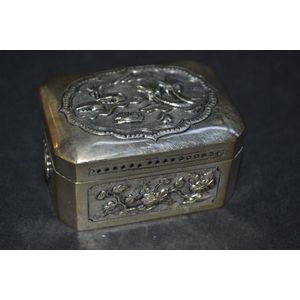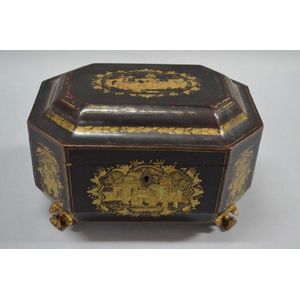Japanese Damascene Gilded Lidded Box
Vintage Japanese damascene lidded box, decorated to lid and sides, on four gilded feet. Marked & 'K24gold' to base. Width 5.5 cm Height 4 cm approx.
You must be a subscriber, and be logged in to view price and dealer details.
Subscribe Now to view actual auction price for this item
When you subscribe, you have the option of setting the currency in which to display prices to $Au, $US, $NZ or Stg.
This item has been sold, and the description, image and price are for reference purposes only.
- Damascene - Damascening is a technique used to decorate metal objects, such as swords, armor, and other metalwork, by inlaying different colored metals into grooves that have been etched or engraved into the surface of the metal. The technique is believed to have originated in Damascus, Syria, and was later adopted by other cultures such as the Japanese, Indians and Iranians.
The process typically involves etching a design into the surface of the metal, and then filling the grooves with a contrasting metal, such as gold or silver. The inlaid metal is then burnished to create a smooth surface, and the design is polished to a high shine. Damascening can create intricate and highly detailed designs, and is often used to decorate weapons, as well as jewellery, and other decorative objects. - Gilding - Gilding is a method of ornamentation whereby a thin sheet of gold metal is applied to items made of wood, leather, ceramics, glass and silver for decorative purposes.
For furniture including mirrors, the sheet of gold is usually applied over a coating of gesso. Gesso is a mixture of plaster of Paris and gypsum mixed with water and then applied to the carved wooden frames of mirrors and picture frames as a base for applying the gold leaf. After numerous coats of gesso have been applied, allowed to dry and then sanded a coat of "bole", a usually red coloured mixture of clay and glue is brushed on and allowed to dry, after which the gold leaf is applied. Over time parts of the gilding will rub off so the base colour can be seen. In water gilding, this was generally a blue colour, while in oil gilding, the under layer was often yellow. In Victorian times, gilders frequently used red as a pigment beneath the gold leaf.
Metal was often gilded by a process known as fire gilding. Gold mixed with mercury was applied and heated, causing the mercury to evaporate, the long-term effect of which was to kill or disable the craftsman or woman from mercury poisoning. The pursuit of beauty has claimed many victims, not the least of which were the artists who made those pieces so highly sought after today.
This item has been included into following indexes:
- oriental objects - boxes 1,852
Visually similar items

Oriental silver petite pill box with cover
Sold by
in
for
You can display prices in $Au, $US, $NZ or Stg.

Antique 19th century Chinese export Chinoiserie tea caddy, standing on carved claw form gilt wood feet, approx 15 cm high, 25 cm long, 12 cm deep
Sold by
in
for
You can display prices in $Au, $US, $NZ or Stg.

Chinese sterling silver miniature photo frame, in the shape of a purse marked YCC, size: 5 by 5 cm including clasp
Sold by
in
for
You can display prices in $Au, $US, $NZ or Stg.

Vintage tortoiseshell and silver lidded box 4.5 cm x 3.5 cm approx
Sold by
in
for
You can display prices in $Au, $US, $NZ or Stg.
